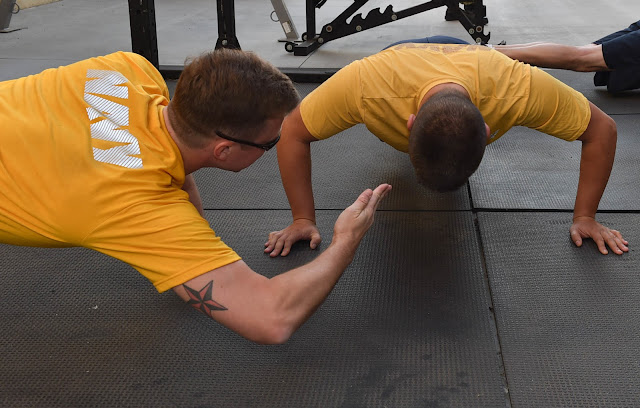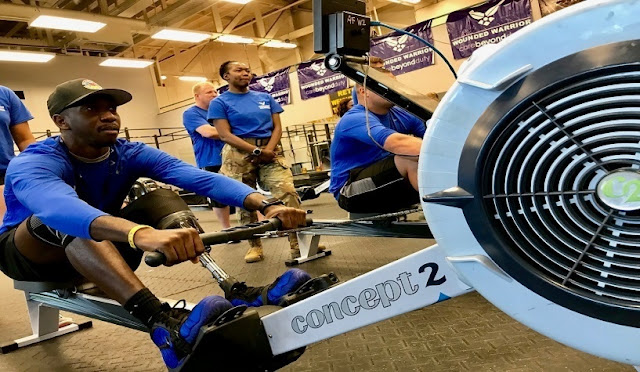Prescription for Push-Ups

Photo by Seaman Jasmine Suarez
Story by Petty Officer 3rd Class Jacob L Greenberg
USS John C. Stennis (CVN 74)
There is a devoted team of fitness and medical professionals aboard the aircraft carrier USS John C. Stennis (CVN 74) in place to ensure Sailors get the most out of their workouts by building biceps while strengthening their mental durability in the process. Exercise, whether an intense mix of weightlifting and aerobics, or trying something new like yoga, is the simplest and most cost-effective solution to a Sailor’s mental distress.
The correlation between physical exercise and having a positive outlook is well-documented. According to a 1999 Duke University study by Dr. James Blumenthal on the effects of simple exercise versus prescription antidepressants, 156 patients underwent a 16-week trial to eventually conclude that consistent, sustained exercise is as effective as populate medications prescribed for depression.
“This study is one of many that proves that exercise improves mood,” said Lt. Blaze Chatham, John C. Stennis’ physical therapist and health promotion director, from Newburgh, New York. “Exercise helps balance three main ‘feel-good’ chemicals in the brain: dopamine, norepinephrine and serotonin. Sailors that are experiencing symptoms of depression, more than just being sad, have an imbalance of these chemicals in their brain. There’s no question that exercise can make them feel better.”
Chatham knows not everyone is an accomplished power-lifter or is able to run a mile in five minutes. The Duke study had patients complete a 30-minute aerobic exercise, plus a 10-minute warm-up and 5-minute cool-down, three times per week for four months, which even the most task-laden Sailors aboard the ship can accomplish.
“Chronic exercise increases dopamine storage in the brain,” said Chatham. “Dopamine is a great mood-booster, helps with motivation, and increases attention spans. [Exercise] raises endorphins and regulates the brain’s neurotransmitters, which are targeted by prescription antidepressants.”
Basically, when a Sailor is feeling especially low, or is experiencing some kind of trauma that is affecting their mood, some time spent in the gym or on the treadmill could be an important part of a solution in dealing with depression.
As a physical therapist in the Naval medicine community, Chatham has heard a litany of excuses as to why a Sailor can’t exercise, but a common thread is not having a workout partner.
“Humans are naturally social creatures, so finding someone to run with or spot you while you pump some iron is great for stimulating the brain,” said Chatham. “Complex group exercise, like yoga or sports, encourage neuron growth as well as release feel-good chemicals.”
Not knowing what exercises to do is also an issue voiced by Sailors. Fortunately, there is a solution already aboard.
Clinton Vinson, John C. Stennis’ afloat training specialist, nicknamed “Fit Boss,” from Munford, Tennessee, is a civilian contracted by the Navy to lead fitness programs for Sailors.
“Leading Sailors through physical fitness is the main reason why I’m here,” said Vinson. “It can be tough [underway]. Sailors get bombarded with stressors that may promote some negative behavior, and I want to get people working out so their struggles don’t manifest into something worse.”
Vinson is a certified physical trainer and can tailor programs to Sailors of all levels of physical skill.
“I love catering workouts for Sailors,” said Vinson. “Sailors are encouraged and welcomed with open arms to come to any of the workout sessions I host around the ship. I’m not a doctor, but I can tell when a Sailor in one of my classes is down-in-the-dumps. By the time we’re done, they’re physically exhausted and have forgotten about whatever small problem or quarrel had them feeling down when they came in.”
Aerobics or high-intensity training might be too much for those getting back into physical fitness. A low-impact exercise, like the ancient practice of yoga, is recommended by both Chatham and Vinson and is conveniently taught on the ship.
Master Chief Navy Counselor Melissa Warren, John C. Stennis’ Administration Department’s departmental leading chief petty officer, from Austin, Texas, has been practicing yoga for 8 years and got her teacher’s certification while stationed at Naval Air Station (NAS) Whidbey Island, Washington.
“From the outside, yoga may seem like it is just about making shapes with your body,” said Warren. “Actually, the ‘shapes’ or movement an onlooker might see are just a way to exert the body in order to clear the mind for meditation. The primary focus of yoga is to prepare the body for meditation.
Students of the art of moving and breathing start at the physical layer of yoga, but later see that through practice, introspection is inspired.
“Yoga is an all-encompassing activity, calling on both the mind and the body to steady one’s inner self,” said Warren. “There’s a reason it’s so widely-used in post-traumatic stress disorder (PTSD) therapy.”
Being at sea for extended periods of time can push the boundaries of any Sailor’s mental strength, but there are numerous avenues aboard the John C. Stennis to mitigate the feelings of depression. Whether connecting movement to breath in a yoga practice or reaching a personal best curling dumbbells, Sailors can find their own way of releasing endorphins to make themselves feel better.
Any Sailor who believes they are suffering from depression is encouraged to reach out to the ship’s medical professionals or to any of the chaplains. All conversations with chaplains are confidential.
The John C. Stennis Carrier Strike Group is deployed to the U.S. 5th Fleet area of operations in support of naval operations to ensure maritime stability and security in the Central Region, connecting the Mediterranean and the Pacific through the western Indian Ocean and three strategic choke points.
“Yoga is an all-encompassing activity, calling on both the mind and the body to steady one’s inner self,” said Warren. “There’s a reason it’s so widely-used in post-traumatic stress disorder (PTSD) therapy.”
Being at sea for extended periods of time can push the boundaries of any Sailor’s mental strength, but there are numerous avenues aboard the John C. Stennis to mitigate the feelings of depression. Whether connecting movement to breath in a yoga practice or reaching a personal best curling dumbbells, Sailors can find their own way of releasing endorphins to make themselves feel better.
Any Sailor who believes they are suffering from depression is encouraged to reach out to the ship’s medical professionals or to any of the chaplains. All conversations with chaplains are confidential.
The John C. Stennis Carrier Strike Group is deployed to the U.S. 5th Fleet area of operations in support of naval operations to ensure maritime stability and security in the Central Region, connecting the Mediterranean and the Pacific through the western Indian Ocean and three strategic choke points.



Comments
Post a Comment